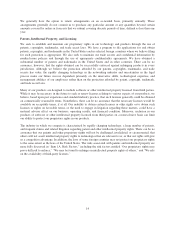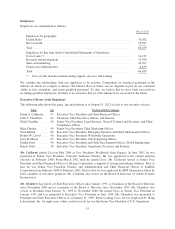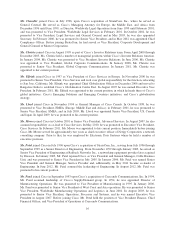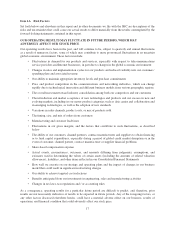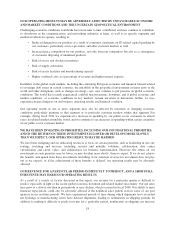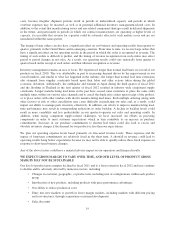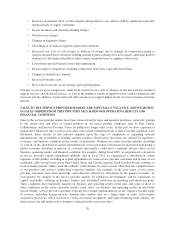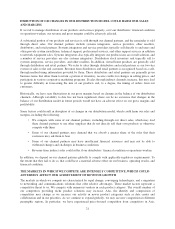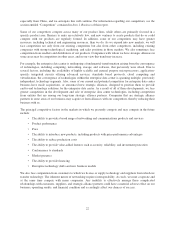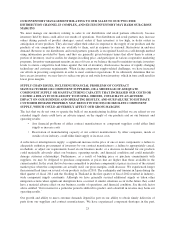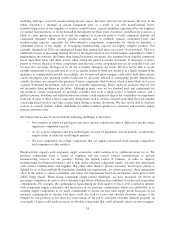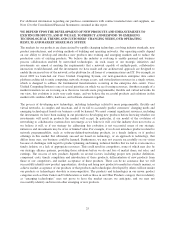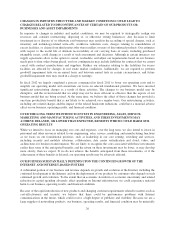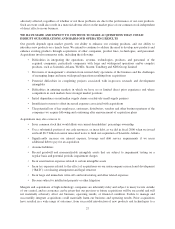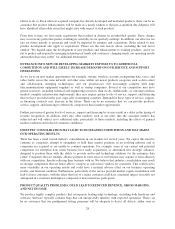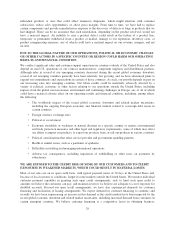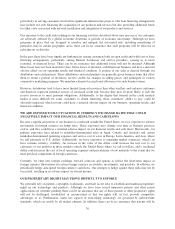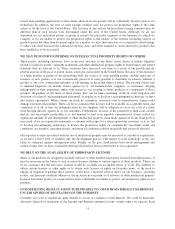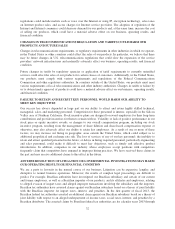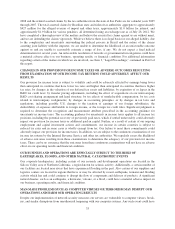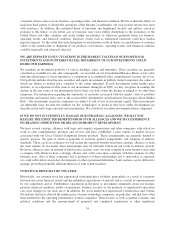Cisco 2012 Annual Report Download - page 32
Download and view the complete annual report
Please find page 32 of the 2012 Cisco annual report below. You can navigate through the pages in the report by either clicking on the pages listed below, or by using the keyword search tool below to find specific information within the annual report.including shortages caused by manufacturing process issues, that have affected our operations. We may in the
future experience a shortage of certain component parts as a result of our own manufacturing issues,
manufacturing issues at our suppliers or contract manufacturers, capacity problems experienced by our suppliers
or contract manufacturers, or strong demand in the industry for those parts. A return to growth in the economy is
likely to create greater pressures on us and our suppliers to accurately project overall component demand and
component demands within specific product categories and to establish optimal component levels and
manufacturing capacity, especially for labor-intensive components, components for which we purchase a
substantial portion of the supply, or re-ramping manufacturing capacity for highly complex products. For
example, during fiscal 2010, we experienced longer than normal lead times on several of our products. This was
attributable in part to increasing demand driven by the improvement in our overall markets, and similar to what is
happening in the industry, the longer than normal lead time extensions also stemmed from supplier constraints
based upon their labor and other actions taken during the global economic downturn. If shortages or delays
persist or worsen, the price of these components may increase, or the components may not be available at all, and
we may also encounter shortages if we do not accurately anticipate our needs. We may not be able to secure
enough components at reasonable prices or of acceptable quality to build new products in a timely manner in the
quantities or configurations needed. Accordingly, our revenue and gross margins could suffer until other sources
can be developed. Our operating results would also be adversely affected if, anticipating greater demand than
actually develops, we commit to the purchase of more components than we need, which is more likely to occur in
a period of demand uncertainties such as we are currently experiencing. There can be no assurance that we will
not encounter these problems in the future. Although in many cases we use standard parts and components for
our products, certain components are presently available only from a single source or limited sources, and a
global economic downturn and related market uncertainty could negatively impact the availability of components
from one or more of these sources, especially during times such as we have recently seen when there are supplier
constraints based on labor and other actions taken during economic downturns. We may not be able to diversify
sources in a timely manner, which could harm our ability to deliver products to customers and seriously impact
present and future sales.
We believe that we may be faced with the following challenges in the future:
• New markets in which we participate may grow quickly, which may make it difficult to quickly obtain
significant component capacity
• As we acquire companies and new technologies, we may be dependent, at least initially, on unfamiliar
supply chains or relatively small supply partners
• We face competition for certain components that are supply-constrained, from existing competitors,
and companies in other markets
Manufacturing capacity and component supply constraints could continue to be significant issues for us. We
purchase components from a variety of suppliers and use several contract manufacturers to provide
manufacturing services for our products. During the normal course of business, in order to improve
manufacturing lead-time performance and to help ensure adequate component supply, we enter into agreements
with contract manufacturers and suppliers that either allow them to procure inventory based upon criteria as
defined by us or that establish the parameters defining our requirements. In certain instances, these agreements
allow us the option to cancel, reschedule, and adjust our requirements based on our business needs prior to firm
orders being placed. When facing component supply-related challenges, we have increased our efforts in
procuring components in order to meet customer expectations which in turn contribute to an increase in purchase
commitments. For example, the earthquake in Japan during the third quarter of fiscal 2011 resulted in industry
wide component supply constraints, and an increase in our purchase commitments which was attributable to us
securing supply components as we made commitments to secure our near term supply needs. Increases in our
purchase commitments to shorten lead times could also lead to excess and obsolete inventory charges if the
demand for our products is less than our expectations. If we fail to anticipate customer demand properly, an
oversupply of parts could result in excess or obsolete components that could adversely affect our gross margins.
24


